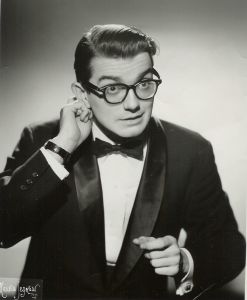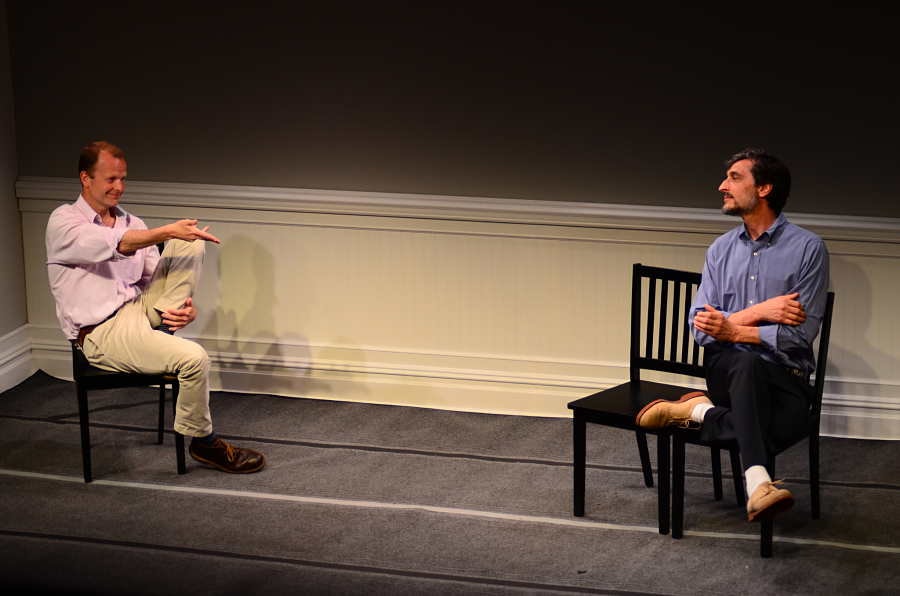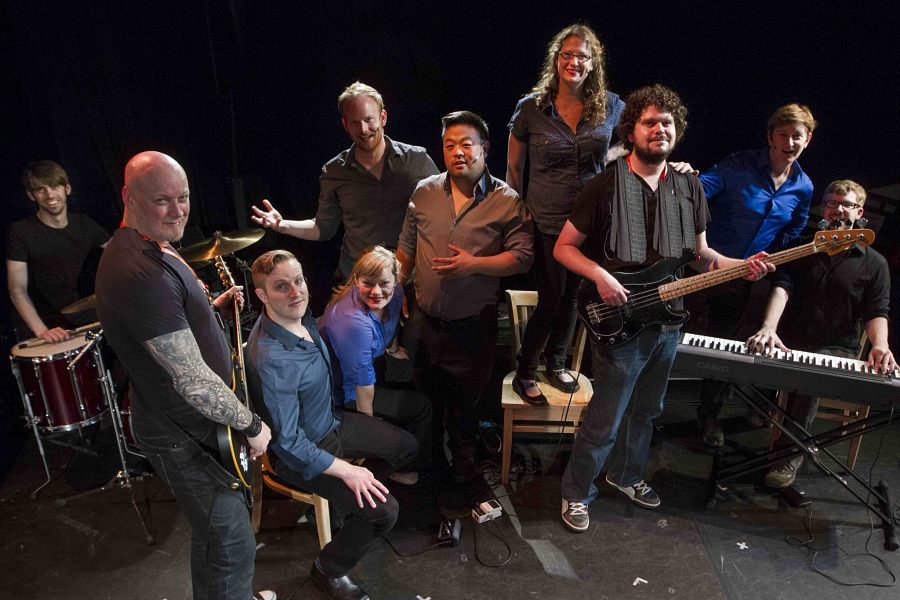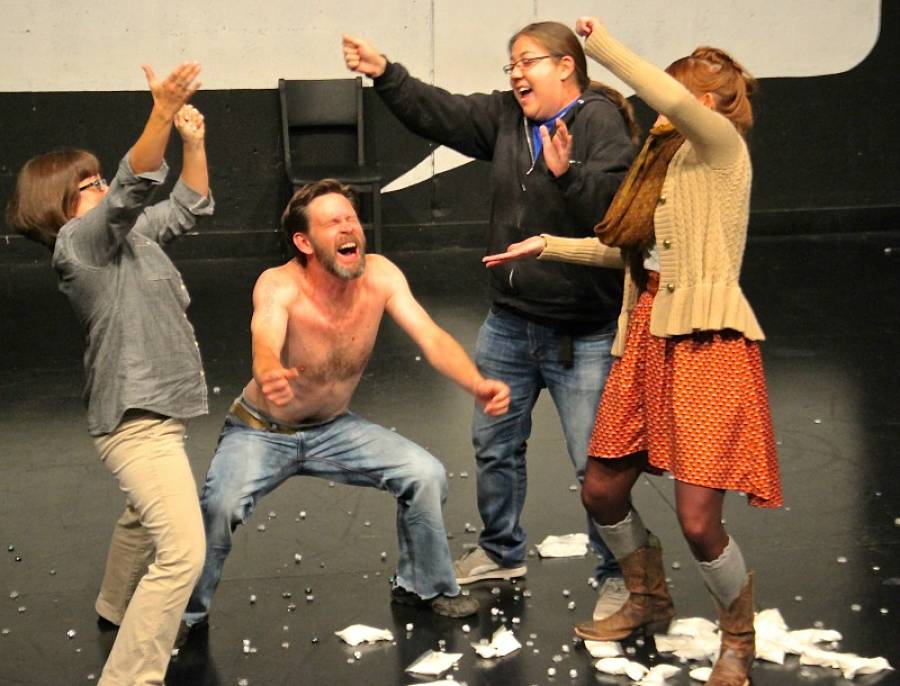“The one reason to be nervous,” says Dave Pasquesi of the Chicago improvisational duo TJ & Dave, “is the potential for large-scale humiliation.”
Pasquesi is referring to an experience he had in fall 2013, when he stood, alongside his partner TJ Jagadowski, in front of 1,100 people on the stage of New York City’s Town Hall. As the lights came up, neither Pasquesi nor Jagadowski had any idea what their show was going to be. They knew nothing about the chatty car salesmen, the strange highway test drive or the peculiar, power-hungry cops with whom the audience were about to become acquainted, thanks to their performance, in the next hour. And they wouldn’t have wanted it any other way.
Click here for our complete special section on longform improv.
As practitioners of what’s known as longform improv, TJ & Dave are slowly but surely helping to bring a purely theatrical brand of impromptu performance to a wider audience. Historically, improv has served a number of purposes—it’s been a tool for teaching kids self-expression, a conduit to channel social unrest, a gateway to scripted satire and a parlor trick to power TV shows. Rarely, outside of the circles of improvisers themselves, has it been considered an art form unto itself.
But as improv enhances more Hollywood movies, as it slips its way into university curricula and onto actors’ résumés, as more showbiz names emerge from comedy theatres—and as a small handful of noteworthy performers like TJ & Dave imagine bolder improvisations in reaction to previous ensembles’ excursions—improv, especially in its long form, is making the strongest case yet for legitimacy.
The popularity of improvisation has grown exponentially in the last 30 years, as once-modest comedy theatres like Chicago’s iO (formerly ImprovOlympic) and New York City’s Upright Citizens Brigade Theatre have expanded to larger venues and into multiple locations across the country. While an increasing focus on improv in college and university training programs gets students hooked on longform and the culture of spontaneous performance, the theatres themselves present budding (and often unpaid) comics’ shows and sell tickets for an accessible $5 to $15.
Mounting longform shows at larger theatres or for extended runs, or charging ticket prices higher than $20, has remained a challenge. “Highly limited” is the way Second City co-founder Bernie Sahlins characterizes improv in his memoir and how-to manual Days and Nights at the Second City. “Momentarily interesting as a game but scarcely sustainable night after night… Presenting pure improvisation inevitably results in the elevation of form over content and the player over the play.”
Sahlins here sums up misgivings that any number of theatre producers are wrestling with: Can something created in the moment generate consistently excellent results? Can it overcome the potentially self-indulgent aspects and connect with an audience in a deep, lasting way? Can its ethereal qualities stand up to that which has been tested and honed?
In short: Can improv be trusted?
When our culture’s improvisational touchstones include Whose Line Is It Anyway? and Will Ferrell’s larkish, off-the-cuff takes in the Anchorman movies, it’s easy to forget the form’s sturdy theatrical foundations.
When David Shepherd and Paul Sills founded America’s first improvisational theatre, the Compass, in 1950s Chicago, they sought to wrangle with the fears of the common man in an idiom anyone could understand. Leaping from the foundational exercises of Sills’s mother, Viola Spolin, the Compass plumbed newspaper headlines and addressed audience concerns in its improvised scene work.
These influential exercises, along with loosely sketched “scenario plays,” looked to channel the era’s political unrest into a “workers’ theatre” that relied on Brecht, not banter. Even so, comedy seemed an inescapable element or byproduct of the form. For example, the Compass helped Mike Nichols and Elaine May hone skills that would later land their partially improvised sketch show on Broadway. When Sills exported improv to his next project, the Second City, in the early ’60s, he and co-founders Bernie Sahlins and Howard Alk used it primarily to generate scripted material.

Then came Del Close. After acting with the Compass, directing at Second City and working with Compass offshoot the Committee in San Francisco, Close became a purveyor of lofty visions about the possibilities of improv. When Charna Halpern convinced him to teach at ImprovOlympic in Chicago during the early ’80s, his art took a leap forward. Until then, his dream of generating a long piece of uninterrupted, improvised theatre that could have a rewarding, artistic gestalt had lingered just out of reach. At iO, though, Close and Halpern codified the structure of Close’s undertakings with the Committee and found a revolutionary variation on an old theme; the form was christened, cheekily (and somewhat unfortunately), “the Harold.”
This innovation—a way of incorporating spontaneous monologues and scenes into a larger framework with recurring characters and themes—did not rely on the audience suggestions or gimmicks of short-form improvisation games. Its experimental nature emphasized the power of cooperation, communication and the potential of the group mind. When it was done well, the Harold could “make your hair stand on end, because you’re in the presence of something coming together in a magical way,” says Jeffrey Sweet, the playwright and theatrical historian whose oral history of the Compass and Second City is called Something Wonderful Right Away. This was, for the first time, improv for improv’s sake.
Sahlins, of course, did not share Close’s faith in improv’s future, and Close felt that it was their disagreement on the matter that led to his second dismissal from Second City. Though Close refined his methods and uncovered what he felt were surefire principles to help guarantee success (all of which are contained in the iO’s improv manual, Truth in Comedy), there were always those who saw Close’s desire for pure improvisation as misguided. According to Sweet, Close felt that “improv’s coming of age would be when an audience would pay admission to see something, and knowing not a word of it would be pre-planned.”
The mercurial guru gained the trust of those he directed—Bill Murray and John Belushi among them—and inspired a remarkable number of students who would go on to comedy fame (Tina Fey, Mike Myers and Amy Poehler, to name a few). But he saw just a part of improv’s progress before he died in 1999.

The maturation of the Harold might be likened to the development of the automobile, with Close in the Henry Ford role. Once the Harold’s invention made form and function clear, many more creative minds began expounding on what the thing could be.
Since its creation, developers—most notably Close’s protégés at the Upright Citizens Brigade—have made the Harold sturdier, faster, more reliable and more resilient. Fancy gimmicks may make the newer models appealing, but they’ve all got the same basic components—and as a passenger, the most exciting ones are those that deliver rides to unknown destinations but never cause fear about the whole thing coming apart in a massive roadside accident.
If longform has a Cadillac, to continue the analogy, it’s TJ & Dave. Ask longtime players as well as those who have little experience with improv: Pasquesi and Jagadowski are the first two names on their lips. The former is one of Close’s earliest iO successes, and his partnership with the latter began 13 years ago. The duo, fueled by a desire to play grounded characters in simple scenarios with the kind of theatrical patience that Close championed, stage “instant plays” of about 50 minutes duration. They unfold slowly and force nothing.
Like Close’s best disciples, TJ & Dave eschew easy chuckles in favor of richer laughs arising from honest give-and-take between players fully invested in their characters. The pair’s often tender portrayals of families, friends, lovers and co-workers exhibit enough specificity to make characters feel like acquaintances, if not intimate relations. The team provides “the ultimate validation of Del’s perspective,” says Sweet.
Scott Morfee had no particular affection for improv when he attended a TJ & Dave show in Chicago, but the producer—who runs New York’s Barrow Street Theatre—couldn’t help but notice “the lines around the block at iO on a Wednesday night” on a visit to Chicago in 2004. He subsequently invited TJ & Dave to his 200-seat proscenium house in the West Village. While the pair’s first trip would presumably attract improv students and comedy fans, Morfee had an inkling they might also appeal to those who’d been watching Barrow Street’s scripted productions.
“They had an ambassadorial flair from the get-go,” says Morfee. “And the show had a mission: We can broaden the idea of what improvisation is by getting more people to see it.”
Morfee’s initial invite to Pasquesi and Jagadowski may have been a sign of faith in their talent, but his enduring quality has been patience. While improv schools like the UCB Theatre, the Peoples Improv Theater and the Magnet Theater previously hosted and got the word out about TJ & Dave, improv is difficult to sell to those without some positive prior exposure. And trying to explicate one of the subtle, fleeting moments that slow improv is capable of—a loaded gesture, glance or intonation that speaks volumes—is nearly impossible.
“We have a hard time explaining what the show is,” Pasquesi concedes. “It’s fun to hear audiences who have not seen this kind of work before, because they’re real quiet at first, and then they catch on: ‘Is this what’s supposed to be happening? Oh, these guys have no idea what’s going on!’”
In 2004, houses for TJ & Dave could be as small as 20 or 30 people, and there were heavy discounts for students. But the more often the duo returned to New York, the more word-of-mouth brought new attendees to Barrow Street. Now the duo sells out four or five shows every three months within days of the theatre’s announcement. The larger, more inclusive audience they bring has included composer David Yazbek, who talked up the show in the New York Times, and John Guare, who invites his Yale playwriting classes.
With the encouragement of Morfee’s Barrow Street producing partner Tom Wirtshafter, TJ & Dave will play the other venue with which Wirtshafter is associated, Town Hall, again in spring 2015. Meanwhile, back in Chicago, Pasquesi and Jagadowski have opened their own theatre, the Mission, under the auspices of iO in its expansive new Lincoln Park location.
There’s no way of knowing how many New York theatregoers this duo has swayed to believing in improv’s efficacy—Morfee figures that a large percentage of spectators believe that TJ & Dave prepare some of the show beforehand and have to come back to be convinced that it’s truly spontaneous.
Others are quick converts. Filmmaker and actor Alex Karpovsky went to the Barrow in 2007 to see TJ & Dave at a friend’s insistence, despite a lack of interest in the form. After just one show, Karpovsky was impressed. “It was almost like a magic act,” he says. “It really made me question bigger things—the underpinnings of human imagination and creativity.” Soon after, the filmmaker convinced Jagadowski and Pasquesi he could make a movie about improv, despite the ineffable qualities that make the form notoriously difficult to capture on film. The final product takes its title from TJ & Dave’s nightly introduction: Trust Us, This Is All Made Up.
Beyond pushing to get TJ & Dave reviewed, setting a regular schedule and encouraging a party atmosphere on the theatre’s mezzanine level among the regular fans, Morfee does not take much credit for the show’s popularity. “Other theatres have asked how we did it, but there was no genius behind it,” says Morfee. “We stuck with it and gave the audience a chance to find us.”
Since TJ & Dave have taken off, though, Morfee has been a quiet evangelist for improv in traditionally theatrical spaces. “It’s low-maintenance,” Morfee maintains. “I don’t know many theatre owners who don’t think, ‘What I need is a lights-up, lights-down show that can earn income late night’—a time at which almost nothing else can run.”

Morfee is practicing what he preaches, inviting a number of other improv troupes to perform at Barrow Street, including two other examples of Close’s ideas made good: a musical improv troupe called Baby Wants Candy and the Improvised Shakespeare Company.
Years before TJ & Dave began playing together, Baby Wants Candy was one of the first iO troupes to veer from the original Harold structure and discover a niche for itself. In Chicago, they’d been toying with music and a live piano accompanist, and decided to show off their work at the Edinburgh Festival Fringe in 1998.
“It’ll be fun—who cares if we get audiences?” says BWC founding member Al Samuels of that trip. “But the show got an incredible response; people had not seen anything like it there.” The troupe subsequently determined to make improvised musicals their calling card. When it takes the stage, BWC asks its audience for the title of a show never made, then launches into a boisterous musical replete with plaintive “I Want” songs and show-stopping finales with full-cast choreography.
“As opposed to something technically brilliant, we always err toward funny,” quips Samuels. “But we still try to tell an amazing story—that’s the key to it.”
Since executive producer Emily Dorezas came on in 2005, the ensemble has consistently booked more and more college shows. BWC currently performs two shows a week in Chicago (once with a full band every Friday at the 460-seat Apollo Theater, and once at the Annoyance Theater). There are runs in both L.A. and New York (where they have members), and anywhere between 100 and 200 additional road dates, primarily at performing arts centers on university campuses. They’ll also play the Edinburgh Fringe, as they have every year since that auspicious bow in ’98. The weekly Apollo show is still $15, but gigs elsewhere can run up to $40 for premium seats.
Though the rollicking Improvised Shakespeare Company is the youngest of these three troupes, its relative growth has been explosive. After an initial experiment in Second City’s Skybox venue in 2005, ISC founder Blaine Swen brought his all-male crew to Halpern at iO, and it has remained there since. Their act, which apes heightened Elizabethan language, moves beyond simple parody while plumbing the Bard’s canon for likely characters, plots and themes.
“People who don’t enjoy Shakespeare much are afraid the show is going to be academic, boring and highbrow,” observes Swen. “People who do enjoy Shakespeare are afraid it’ll be broad parody that’s goofy and blasphemous. We have to overcome these misperceptions to get them through the door, so they can see that while it plays with Shakespeare, it pays homage to him at the same time.”
When producer and talent manager Kirsten Ames saw the troupe’s highly physical and playfully poetic romping, she signed on to help them book and promote gigs outside the Midwest. In addition to doing three shows a week at iO, the ISC now tours about 100 dates on campuses and PACs, and sells out shows in both Los Angeles and New York. On the coasts, tickets fetch $35, but these days the ISC could charge more just for the chance that their latest recurring cast member will drop in. That poor player: Sir Patrick Stewart.
Stewart was seduced into playing with ISC at Theatre 80 in New York after meeting several ensemble members during a collaboration between Second City and Lyric Opera in 2013. He has now improvised in seven shows with the troupe, and recently requested that he be introduced not as a guest artist but a company member. (Read Stewart’s own account of his improv baptism here).
Big names like Stewart’s sell tickets, of course, but not every show has the benefit of a relationship with a famous master thespian. Ames, who produced one of New York’s earliest longform successes with the troupe Burn Manhattan in the late ’90s, understands the doubts of backers all too well.
“Everyone wants to know what they’re going to get, but producing improv is almost like an exercise in improv itself: Everybody just has to trust and say ‘Yes.’ A tech guy wants the lights to be perfect because that’s his job, and so, for him, it’s got to be like, ‘What?’ But after one show with good improvisers, he’ll realize, ‘Oh, I can just have fun. If they walk out in the dark, they’ll make that work. Anything works.’”

Beyond the booming successes of these three troupes, there have been further signs of longform reaching the theatrical mainstream. Established regional producers have begun to see longform as a way of engaging nontraditional audiences. Emily Tarquin, an artistic associate at Denver Center for the Performing Arts and the producing curator of its “theatrical testing” arm, known as Off-Center, launched a periodic night of improv called Cult Following at the 200-seat Jones Theater in 2011. A $15 admission includes popcorn, two beers and an improv show revolving around a set theme. Though there are conceptual frameworks—this year, patrons can enjoy a karaoke musical, a pirate ship exploit and a night of romantic confessionals—each show is primarily a loose Harold that, like BWC or ISC, plays with recognizable genre tropes.
“Intentionally, it’s a brand that speaks to people who might want a rowdier night out,” says Tarquin. “As a theatre organization, you’re always thinking younger, because that’s the audience you don’t reach. But we just expanded that to ‘It’s an adventure.’ As a result, we’ve had 80-year-olds in the audience, and we’ve had babies, because their parents were that cool.” She doesn’t see Cult Following as anathema to DCPA’s scripted mainstage programming, referring to the show’s “unscripted theatre” tagline: “It’s taking what we do on a daily basis at the theatre, but really throwing it up to the unexpected.”
Whether the DCPA will one day be able to charge top prices for Cult Following is hard to know, but one thing is clear: The culture surrounding longform has evolved, and is becoming more inclusive as time goes by. “In the ’80s, we used to stand outside and beg people to come in,” Halpern notes. “Things have changed. I now have a 40,000-square-foot building that’s packed every weekend.”
Before his death last year, even Second City’s Sahlins had second thoughts about longform—sort of. Sahlins went to see TJ & Dave while in his mid-80s and congratulated the players after their set. Impressed though he may have been, according to Pasquesi, his parting words were, “Well, you two can do it. It doesn’t mean it can be done.”
And perhaps that’s enough. While Close maintained faith in longform, empirical proof onstage is where it counts—and where improv will have its ultimate vindication.
Matthew Love is a writer and sometime improviser based in Brooklyn. He has contributed to Rolling Stone, Condé Nast Traveler, and Time Out New York, among other publications.


